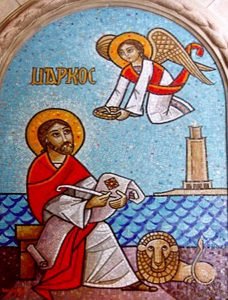 Prior to the Holy Days that we just celebrated, I shared some of the key words that St. Mark embedded in his narrative. They were deliberately used by Mark to make a point. Mark also uses patterns and design to shape his narrative.
Prior to the Holy Days that we just celebrated, I shared some of the key words that St. Mark embedded in his narrative. They were deliberately used by Mark to make a point. Mark also uses patterns and design to shape his narrative.
Mark shapes his narrative in patterns of twos and threes. The reader will be first aware of doublets. Some-times this is a matter of repeating episodes; some-times it is a matter of echoing words. There are, for example, two instances in Mark when Jesus calms the sea. Twice he multiplies bread for a hungry crowd. There are two occasions when people discuss who Jesus is. There are two instances in which Jesus gives specific instructions to his disciples. And there are numerous other examples. If you truly want to learn more about the Gospel of Mark, why not pick up your New Testament (NT) and try to find these doublets.
At the end of Chapter 8, Mark seems to give a reason for his method when he describes Jesus’ healing of a blind man in two stages. Here he dramatizes the idea that the blind man cannot shift from darkness to vision all at once; he needs to go through a process of coming to sight. In the same way, careful readers will find that each repetition enlarges their understanding.
Further, Mark’s whole Gospel is divided into two parts and Mark has worked out this structure to shift the reader’s perceptions from a conventional to an unconventional way of seeing. We must always remember that this Gospel, like the others, was written to attract and convince others that Jesus IS the Messiah, the Savior.
Mark also likes to pattern things in threes. There are three healing miracles, for example, in chapter 1, three questions asked of Jesus in chapter 2, three seed parables in chapter 4. Jesus has three chief disciples (Peter, James and John), whom he takes with him on three key occasions (Chapter 5: the raising of Jarius’ daughter; chapter 9: his transfiguration; and chapter 14: his agony in the garden). There are also three key anonymous women who are healed in the first part of the Gospel. In the second part, three women (two Marys and Salome) who follow Jesus to Jerusalem, watch where he is laid in the tomb, and then come to anoint Him (chapters 15 and 16).
As with the doublets, there are numerous other examples. If you become alert to this pattern, you will see that Mark always uses the middle of these triads to shed light on the other two.
Marks whole Gospel might also be viewed as having three parts. The middle of this large triad, shedding light on both sides, is the scene of His transfiguration. So you see there is much more to Mark’s Gospel that meets the eye. This is also true of the other four Gospels. They are not history but documents of faith.
